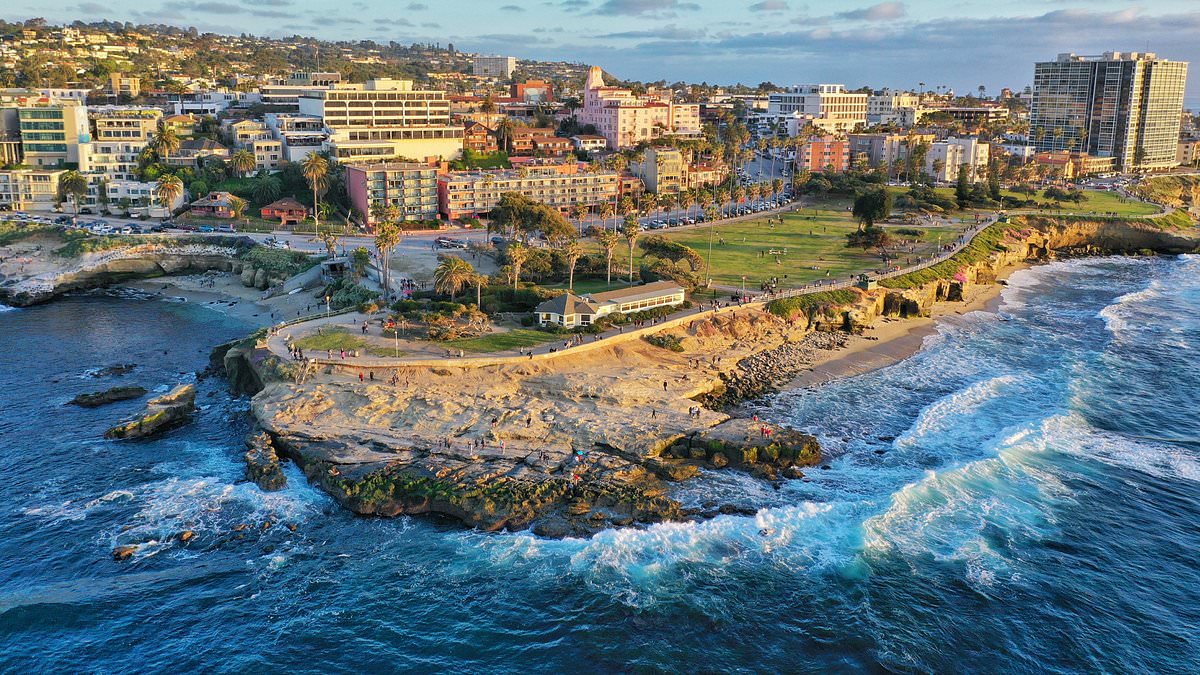It is the height of summer, but one of America’s most iconic beaches is practically deserted once again.
Tourists visiting San Diego normally can’t wait to visit La Jolla Cove, a stunning coastline known for its gorgeous sunsets and sandstone cliffs.
However, the picturesque shore is also home to hundreds of sea lions and seals, along with thousands of pelicans and other birds which visitors say are producing an unbearable stench.
In fact the odor has become so unbearable, tourists are saying they’ve decided to stay home.
Barbara Cohen, a first-time visitor to La Jolla, told Fox 5 San Diego that the smell caught her off guard.
‘This is my first time in La Jolla and it’s beautiful, it’s everything I thought it would be,’ Cohen said. ‘But the first thing I noticed was the smell. And the second thing I noticed, these rocks are very, very white.’
Margaret Elizabeth-Lacobazzi, a lead server at nearby Blue Ocean / Harumama told the local outlet that despite the smell getting worse, it hasn’t affected her restaurant’s business yet.
According to her, that’s likely because the Asian fusion restaurant has plenty of indoor seating that allows customers to get spectacular views of the cove.
‘The location’s stunning view of the La Jolla Cove really draws people in,’ she said. ‘Sometimes the smell is a bit potent, so people will just go inside and eat.’
The city has addressed the foul smell at La Jolla Cove before.
The problem got so bad in 2016 that the city solicited solutions from anyone and everyone who had ideas, reported La Jolla Village News.
Proposals included power washing the cliffs, to installing spikes or leaving tarps on them to stop wildlife from roosting. Someone even proposed letting trained falcons loose to scare gulls away.
The city ultimately chose Blue Eagle, a San Rafael-based firm, to release its mix of bacillus bacteria on the cliffs to consume the bird and seal droppings.
This option was chosen because bacillus is a naturally occurring ocean bacteria and is known for their ability to break down waste in an environmentally-friendly manner.
‘The city has long worked to address persistent odor concerns at the La Jolla bluffs, which are caused by natural accumulations of seabird and marine mammal waste,’ Benny Cartwright, supervising city spokesperson, told Daily Mail.
‘In previous years, the city applied an organic, enzyme-based treatment derived from naturally occurring ocean bacteria to targeted areas as part of a successful odor mitigation strategy,’ Cartwright added.
‘The treatment uses beneficial microbes to accelerate the natural breakdown of bird and marine mammal waste, effectively reducing odors while posing no known risk to wildlife or water quality.’
Nine years later, the smell has returned, largely because in 2023 the city stopped using the bacteria.
This is because the Regional Water Quality Control Board requested more data on how the use of the bacterial spray was affecting the environment.
‘The city continues to pursue the additional internal review and approvals to resume spraying in the future,’ Cartwright said.
‘Any future application would continue to be guided by established best management practices, including avoidance of application during or near the presence of marine mammals using on-site biological monitoring, and implementation only under appropriate weather and tide conditions,’ he added.
Megan Heine, the owner of Brockton Villa Restaurant in La Jolla, said the city should get back to spraying.
‘The odors, caused primarily by bird guano on the rocks, remain as their population has increased. Some days are better than others. At Brockton Villa, we use “scent air” fans to mitigate any odor so people don’t complain once they’re in our restaurant,’ she said.
La Jolla is home to around 250 to 250 sea lions alone, according to the Sierra Club Seal Society. The beach also typically welcomes around seven million visitors annually.
